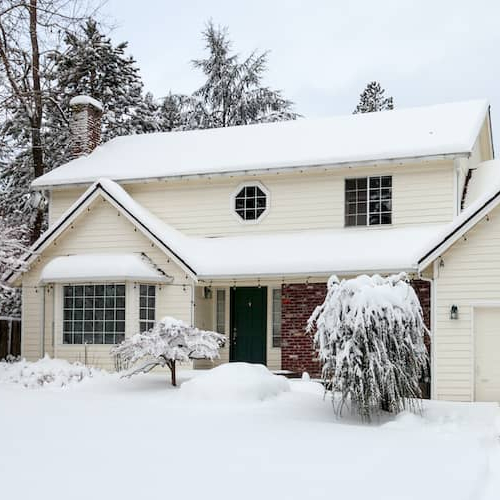What is PMI? Private mortgage insurance defined and explained
Jun 25, 2025
•8-minute read
If you take out a conventional loan to buy a home and with a down payment that’s less than 20%, you’ll need to pay for private mortgage insurance. PMI reimburses your lender if you default on your mortgage payments. While you can’t opt out of paying for PMI, knowing how it works can help you better manage your payments and understand how you can cancel it.
What is PMI?
PMI protects your lender if you default on your mortgage. Lenders require it for borrowers with a conventional loan and less than 20% home equity. Borrowers with a smaller down payment are riskier for lenders and PMI mitigates against that risk.
For example, if you buy a home for $400,000 with a conventional loan, you’d need a down payment of at least $80,000 to avoid paying PMI. If you make a smaller down payment, you will pay for PMI until you have 20% equity. Lenders usually cancel PMI automatically once you’ve paid down your balance enough to reach 22% equity in your home.
If your home value increases enough to get you to 20% equity, you can refinance your mortgage to eliminate PMI, though you would have to pay closing costs to do so.
PMI applies to conventional loans. Other types of loans require their own types of mortgage insurance. For example, FHA loans require mortgage insurance premiums, which are similar to PMI.
Types of PMI
There are two types of PMI: borrower-paid and lender-paid.
Borrower-paid PMI
Borrower-paid PMI is the most common type. With this type of PMI, your insurance payment is added to your monthly mortgage payment. Keep in mind that it’s not the same as the expenses you pay through escrow, such as homeowners insurance, property taxes and homeowners association fees.
You also may have the option to pay for PMI up front or through a combination of an up-front fee and a lower monthly premium.
Lender-paid PMI
With lender-paid PMI, your lender pays for mortgage insurance with a lump sum when you close your loan. In return, you accept a higher interest rate on your mortgage. Unlike borrower-paid PMI, you can’t cancel lender-paid when your equity hits 20% because it’s paid in full up front.
If you wanted to lower your mortgage payments at this point, you would need to refinance to a lower interest rate. It’s important to discuss which type of PMI your lender plans to use in advance, so you know what to expect when it comes to your monthly payments and interest rate.
How much is PMI?
PMI, like other types of insurance, is based on insurance rates that can change daily. You can typically expect PMI to cost anywhere from 0.2% – 2% of your original loan amount per year.
Private mortgage insurance example
Let’s take a second and put those numbers in perspective. If you buy a $300,000 home, you could be paying somewhere between $600 - $6,000 per year in mortgage insurance. This cost is broken into monthly installments to make it more affordable. In this example, you’re looking at paying $50 - $500 per month as part of your mortgage payment.
Factors that influence the cost of your private mortgage insurance
Your lender also will consider a few other factors when determining how much PMI you’ll have to pay.
Down payment amount
The size of your down payment plays a big role in determining how much you’ll have to pay for PMI. A smaller down payment can represent higher risk for the lender, meaning the lender stands to lose a larger investment if you default and your home goes into foreclosure. As a result of the increased risk, you’ll likely have to pay more for PMI.
A lower down payment also means your regular mortgage payments will be higher and it will take longer before you’re able to cancel PMI. Even if you can’t afford a down payment of 20%, increasing your down payment can reduce the amount of PMI you’ll have to pay.
Credit history
Your lender also will review your credit history to assess your borrowing habits. Your credit score can indicate how reliably you’ve paid back what you’ve borrowed in the past. A higher credit score indicates to lenders that:
· You don’t borrow more than you can pay back.
· You pay your bills on time.
· You avoid maxing out your credit limit.
A lender may charge you less in PMI premiums if you have a solid credit history and high credit score. If you have a lower credit score, your lender may have less faith in your ability to manage your debt responsibly and charge you a higher rate for PMI.
Loan type
Your loan type can also influence how much you’ll have to pay in PMI. For example, fixed-rate loans can reduce the risk of default because the rate won’t change, leading to consistent mortgage payments. Less risk can mean a lower mortgage insurance rate, meaning you might not need to pay as much for PMI.
Adjustable-rate mortgages have an interest rate that can go up or down based on the market. As a result, ARMs come with more risk because it is harder to predict what your mortgage payment will be in the future. However, because ARMs also typically have lower initial interest rates than fixed-rate mortgages, you may be able to pay more toward your principal, build equity faster, and stop paying for PMI sooner.
How to avoid PMI
With all the other costs that come with your mortgage, it’s certainly understandable why you might want to avoid the added cost of PMI. Luckily, it’s possible to get out of paying for it, but it will depend on whether you have borrow-paid or lender-paid PMI.
How to avoid borrower-paid PMI
There are a few ways you can avoid having to add PMI to your monthly payment. You could make a down payment of at least 20%, take out a government-backed loan, or take out a piggyback loan.
Make a larger down payment
You can avoid PMI altogether with a down payment of at least 20%, or you can request to remove it when you reach 20% equity in your home. Once you reach 22%, BPMI is often removed automatically.
Take out an FHA or USDA loan
While it’s possible to avoid PMI by taking out a different type of loan, Federal Housing Administration and U.S. Department of Agriculture loans have equivalent fees in the form of mortgage insurance premiums and guarantee fees.
Unlike PMI that can be cancelled, these mortgage options require you to pay for insurance for the life of the loan. There’s an exception if you take out an FHA loan with a down payment of 10% or more, in which case you would pay MIP for 11 years. Otherwise, expect to pay these premiums until you pay off the house, sell it, or refinance through an FHA Refinance, if eligible.
Take out a VA loan
The only loan without true mortgage insurance is the Veterans Affairs loan. Instead of mortgage insurance, VA loans have a one-time funding fee that’s either paid at closing or built into the loan amount. You may hear the VA funding fee referred to as VA loan mortgage insurance, but it works differently.
The size of the funding fee varies according to the amount of your down payment or equity and whether it’s a first-time or subsequent use of your VA loan benefits. The funding fee can be anywhere between 1.25% - 3.3% of the loan amount. On a VA Streamline, also known as an Interest Rate Reduction Refinance Loan, the funding fee is always 0.5%.
It’s important to note that you don’t have to pay this funding fee if you receive VA disability or are a qualified surviving spouse of someone who was killed in military action or passed because of a service-connected disability.
Take out a piggyback loan
Another way to avoid PMI on a conventional loan is to take out a piggyback loan. Here’s how this works: You make a down payment of around 10% and use a second mortgage, often in the form of a home equity loan or home equity line of credit (HELOC), to pay the rest of your 20% down payment. Rocket Mortgage® doesn’t offer HELOCs, but we’ll explain them so you can understand all your options.
A piggyback loan can help you avoid PMI, but you’ll have to make payments on a second mortgage. Not only will you have two payments, but the rate on the second mortgage will be higher because your primary mortgage gets paid first if you default. If you can’t keep up with the payments on both mortgages, you can lose your home. A piggyback loan is an added financial burden, so be sure to do the math and determine whether you’re saving money or if it just makes sense to pay for PMI.
How to get rid of PMI if you already have it
If you’re paying PMI on a conventional loan, ask your lender how to cancel it once you’ve reached 20% equity. If you're a Rocket Mortgage client, call (800) 508-0944.
For your lender to honor your request to cancel mortgage insurance, you have to be current on your mortgage payments and an appraisal must verify the current property value.
If you don’t request the mortgage insurance cancellation on a single-unit primary property or second home, PMI is automatically canceled when you reach 22% equity based on the original loan amortization schedule.
Canceling PMI on a multiunit property
If you have a multiunit primary property or investment property, cancelling PMI works a bit differently.
Fannie Mae lets you request cancellation of your PMI once you reach 30% equity, while Freddie Mac requires 35% equity. Freddie Mac doesn’t automatically cancel mortgage insurance on multiunit residences or investment properties. Fannie Mae mortgage insurance cancels halfway through the loan term if you do nothing.
FAQ
Here are answers to some common questions about PMI.
Why do I have to pay for PMI?
You must pay for PMI if you make a small down payment on a conventional loan to reduce the lender’s additional risk. This coverage protects the lender if you can’t keep up with your mortgage payments.
What's the difference between PMI and mortgage protection insurance?
Unlike PMI, which is solely for the lender's protection, mortgage protection insurance continues to cover your mortgage payments after you die. This insurance can help protect your family members facing foreclosure on the property after your death. This insurance is sometimes referred to as mortgage life insurance.
Should I pay off my PMI early?
Canceling your mortgage insurance as soon as you’re able can save you big on your monthly payments. If you have a 30-year fixed-rate loan for $300,000, you'll have nine payments left between reaching 20% equity and having your PMI automatically canceled at 22% equity. If you cancel early, you could save thousands of dollars, depending on your interest rate.
The bottom line: PMI explained
Your specific PMI rate, how long you’ll have to pay for PMI, and whether BPMI or LPMI is better for you depend on your individual loan and your unique financial situation. When you’re shopping for a home, ask your lender how they handle mortgage insurance and how much you could expect to pay in PMI – or another type of mortgage insurance.
Are you ready to begin the home buying process? If so, start your mortgage application online with Rocket Mortgage today.

Rory Arnold
Rory Arnold is a Los Angeles-based writer who has contributed to a variety of publications, including Quicken Loans, LowerMyBills, Ranker, Earth.com and JerseyDigs. He has also been quoted in The Atlantic. Rory received his Bachelor of Science in Media, Culture and Communication from New York University.
Related resources

6-minute read
Promissory notes: What are they?
A promissory note is a repayment agreement between a borrower and lender, but how does it differ from a loan? Read on to see how promissory notes affect you.
Read more

6-minute read
What is assessed value and how is it determined?
Learn what assessed value means, how it's calculated, and how it affects property taxes. Know the differences between assessed, appraised, and market values.
Read more

6-minute read
What does collateral mean and how does it work?
Collateral is an asset used to secure a loan. If a borrower defaults, the lender can take the collateral to recover losses.
Read more